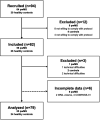Continuous monitoring with wearables in multiple sclerosis reveals an association of cardiac autonomic dysfunction with disease severity
- PMID: 35677598
- PMCID: PMC9168869
- DOI: 10.1177/20552173221103436
Continuous monitoring with wearables in multiple sclerosis reveals an association of cardiac autonomic dysfunction with disease severity
Abstract
Background: Dysfunction of the autonomic nervous system is common in multiple sclerosis patients, and probably present years before diagnosis, but its role in the disease is poorly understood.
Objectives: To study the autonomic nervous system in patients with multiple sclerosis using cardiac autonomic regulation measured with a wearable.
Methods: In a two-week study, we present a method to standardize the measurement of heart rate variability using a wearable sensor that allows the investigation of circadian trends. Using this method, we investigate the relationship of cardiac autonomic dysfunction with clinical hallmarks and subjective burden of fatigue and autonomic symptoms.
Results: In 55 patients with multiple sclerosis and 24 healthy age- and gender-matched controls, we assessed the cumulative circadian heart-rate variability trend of two weeks. The trend analysis revealed an effect of inflammation (P = 0.0490, SMD = -0.5466) and progressive neurodegeneration (P = 0.0016, SMD = 1.1491) on cardiac autonomic function. No association with subjective symptoms could be found.
Conclusions: Trend-based heart rate variability measured with a wearable provides the opportunity for unobtrusive long-term assessment of autonomic functions in patients with multiple sclerosis. It revealed a general dysregulation in patients with multiple sclerosis.
Keywords: autonomic nervous system; cardiac autonomic dysfunction; heart rate variability; multiple sclerosis; progressive; wearable.
© The Author(s), 2022.
Conflict of interest statement
Declaration of conflicting interests: The author(s) declared no potential conflicts of interest with respect to the research, authorship, and/or publication of this article.
Figures




References
-
- Noseworthy JH, Lucchinetti C, Rodriguez Met al. et al. Multiple sclerosis. N Engl J Med 2000; 343: 938–952. - PubMed
-
- Jänig W. Autonomic nervous system. In: Schmidt RF, Thews G, Herausgeber D. (eds) Human physiology [internet]. Berlin, Heidelberg: Springer, 1989, pp.S. 333–70. Verfügbar unter.
-
- Cortez MM, Nagi Reddy SK, Goodman Bet al. et al. Autonomic symptom burden is associated with MS-related fatigue and quality of life. Mult Scler Relat Disord 2015; 4: 258–263. - PubMed
-
- Disanto G, Zecca C, MacLachlan Set al. et al. Prodromal symptoms of multiple sclerosis in primary care. Ann Neurol 2018; 83: 1162–1173. - PubMed
LinkOut - more resources
Full Text Sources

